Brine Availability Test in Salt (BATS)
WHAT:
The Brine Availability Test in Salt (BATS) is a series of horizontal-borehole tests being conducted by the DOE Office of Nuclear Energy (DOE-NE) in the salt at the DOE Office of Environmental Management’s (DOE-EM) Waste Isolation Pilot Plant (WIPP), near Carlsbad NM.
WHO:
BATS is a DOE-NE funded collaboration between Sandia, Los Alamos, and Lawrence Berkeley national laboratories. Sandia National Laboratories is the overall technical lead on the project. The WIPP Test Coordination Office (TCO), part of Los Alamos National Laboratory, provides on-site support and interfaces with the WIPP site contractor. Our team is also collaborating with National Energy Technology Laboratory.




WHEN/WHERE:
The drilling of boreholes and setup of instrumentation occurred in 2019, while testing began in January 2020. The tests are ongoing in nearly identical borehole arrays (heated and unheated – see figure) in the N-940 drift of the WIPP underground (650 m below land surface in the Permian Salado Formation). Preliminary “shakedown” tests were conducted in existing boreholes in the E-140 drift at WIPP in 2018. Some aspects of test design were refined in these tests, and useful data was also collected.

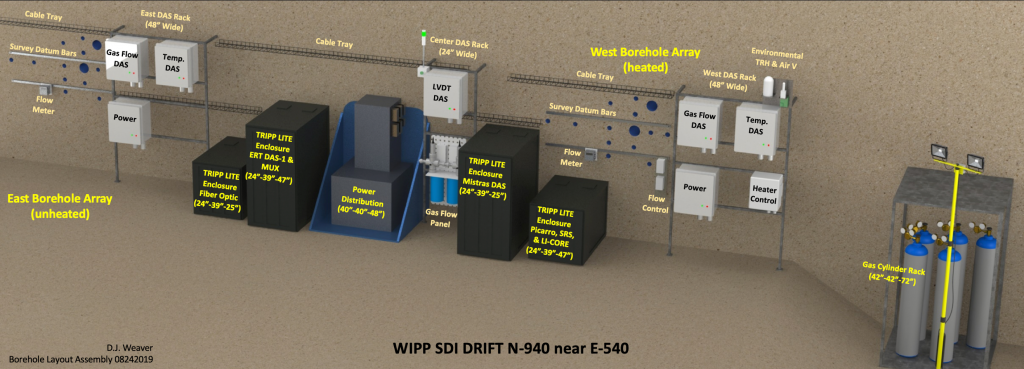
Background and rationale for the test:
Geologic bedded salt deposits are being considered by DOE-NE (along with argillite and crystalline rocks) as a potential disposal medium for heat-generating radioactive waste. Research into salt’s unique properties and behavior has been going on for decades (i.e., since Project Salt Vault in the 1960s- Bradshaw & McClain, 1971), and DOE-NE believes a generic field test centered on brine migration is the next step. The WIPP facility is licensed and operating for permanent disposal of non-heat generating transuranic (TRU) waste. DOE-EM has allowed the DOE-NE BATS team to use an existing experimental drift – away from disposal operations – for conducting the BATS test.
About the BATS Test and Brine Availability
In BATS, understanding “Brine Availability” requires investigating two things:
- What types of water are found in bedded salt deposits?
- What are the transport properties of the salt, and how do they change with time and temperature? How do these properties control how brine flows to a room or borehole?
Water in Salt
One of salt’s key benefits for disposal of radioactive waste is its relative dryness (i.e., lack of circulating groundwater). Even though bedded salt has much less water than most rocks (≤5% by volume), salt is not completely dry. Water is found in salt in different and more variable forms than in many other rocks.
Our research into Brine is important because brine in a salt radioactive waste repository can lead to:
- Corrosion of metal waste containers;
- Corrosion and dissolution of metal wastes themselves; and
- Transport of dissolved wastes in liquid form.
The main types of water or brine we consider in bedded salt at WIPP are (ranked from biggest to smallest contribution):
- Brine in the pores of clay (clay can be ~25% brine by volume).
- A small amount (~1 to 2%) of disseminated clay is found through some layers of the salt
- Discrete and continuous cm-scale clay layers are found in bedded salt deposits
- Brine in fluid inclusions (sometimes called “negative crystals”) in the salt are about 1 to 2% by volume (called “intragranular brine”).
- Water associated with common evaporite minerals, including gypsum: CaSO 42(H 2O), polyhalite: K 2Ca 2Mg(SO 4) 4·2(H 2O) and Carnallite: KMgCl 3·6(H 2O).
- Brine between salt grains, also called “intergranular brine”.
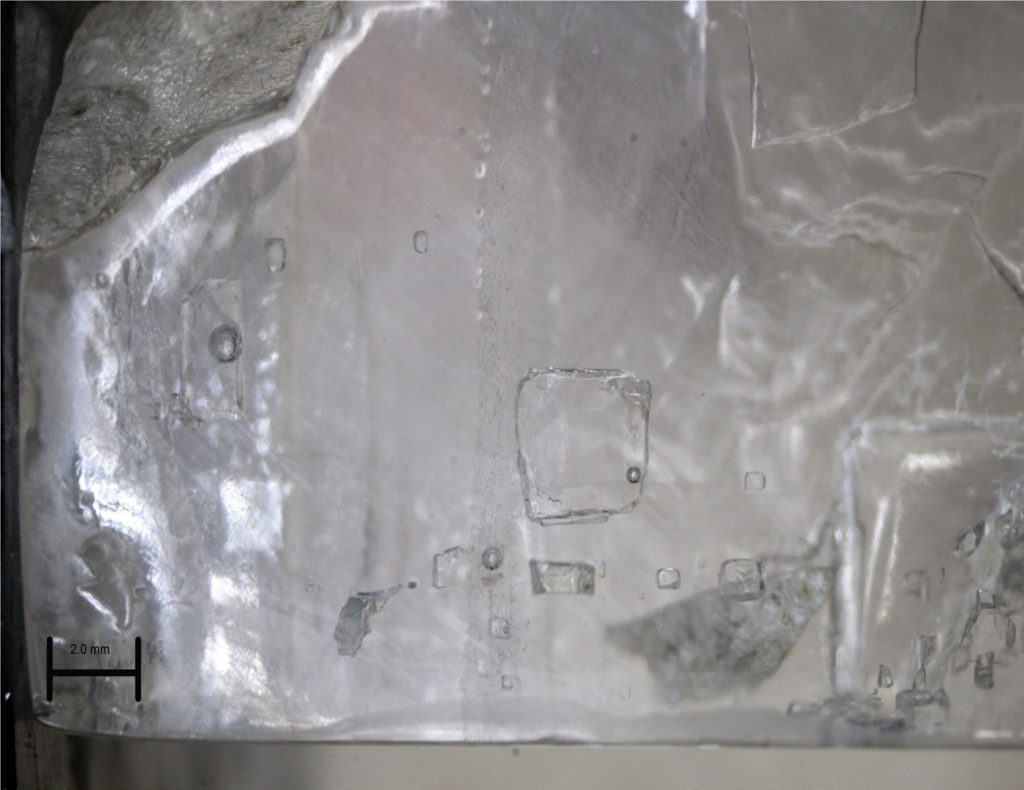
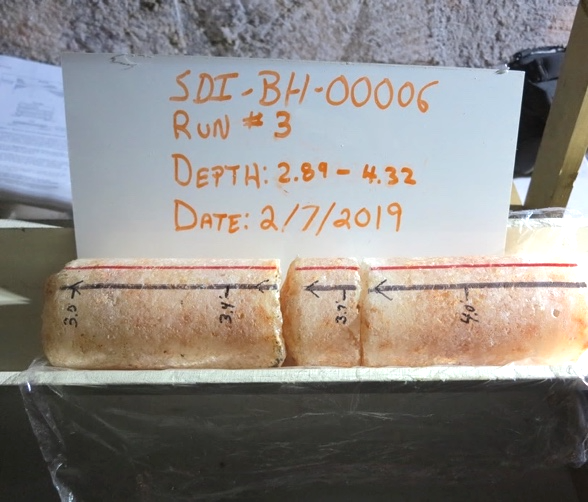
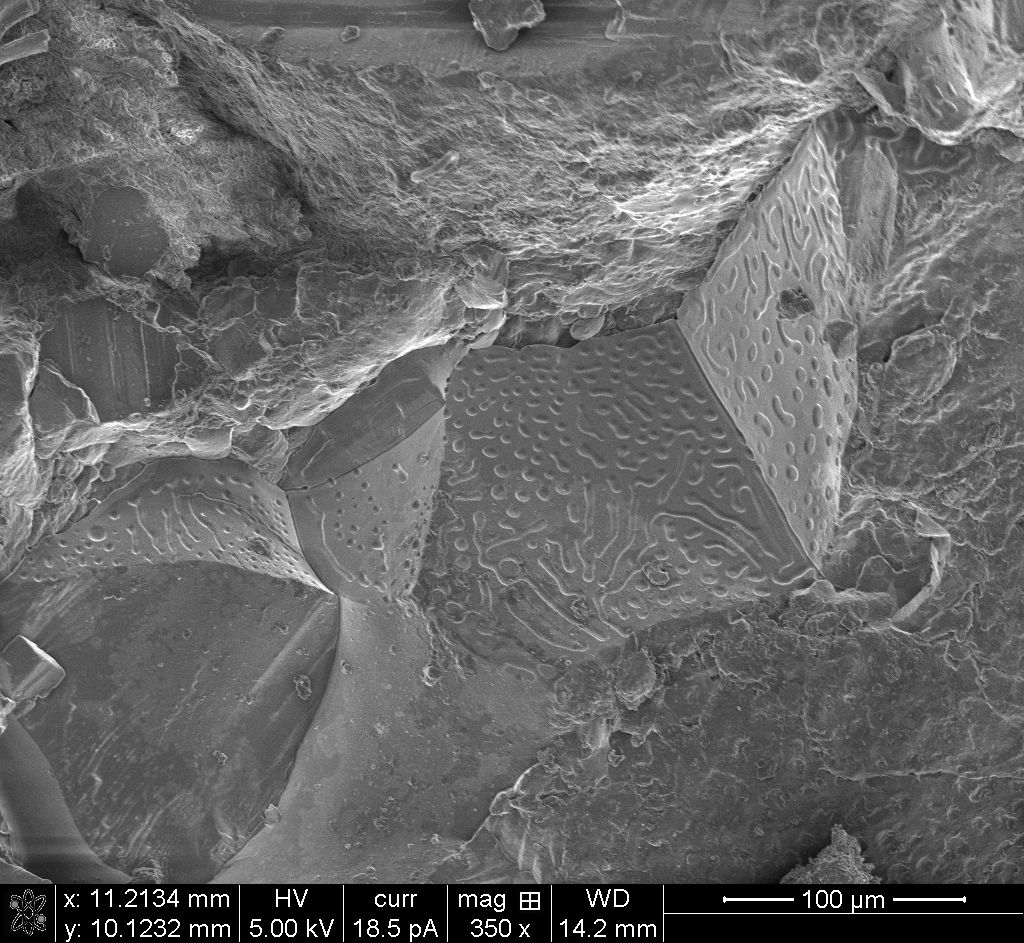
These types of water each respond differently to changes in pressure or temperature. We must first understand what forms of water are present, so we may better predict
- how much of it would eventually flow into a borehole or room,
- how fast it would flow, and
- how to characterize the amount of water in salt.
Better understanding the system and improving our ability to predict brine behavior in salt can ultimately lead to designs or location criteria for a salt repository to minimize the amount of water that would interact with radioactive waste placed in that repository.
Transport Properties of Salt
Another key benefit of salt for radioactive waste disposal is its low permeability and porosity. These properties control how brine or gas moves through a rock, and away from excavations the salt is essentially impermeable (i.e., water and gas cannot move). Mining out the underground rooms at WIPP damages and cracks the salt in the walls surrounding the rooms, and increases its ability to transport gas and brine (i.e., the Excavation disturbed Zone [EdZ] and the Excavation Damaged Zone [EDZ]). The behavior of the salt around an excavation is a complex interplay of the following processes:
- Salt has very low or no connected porosity far from the excavation (<0.1%) but has higher connected porosity near the excavation (~10 to 20%).
- Salt porosity is completely filled with brine away from the excavation, but it is mostly filled with air near the excavation.
- Salt has low or no permeability to brine or gas movement far from the excavation, but the higher porosity is associated with much higher permeability near the excavation.
- Increases in temperature cause the salt and brine to thermally expand, closing up some of the damage-derived porosity (and reducing permeability) near the heat source.
- Over the long-term salt flows like a very viscous liquid (i.e., creep), eventually closing rooms and boreholes (rooms close on the order of several cm/year). This process also closes damage-related porosity and permeability that had formed when making the excavations.
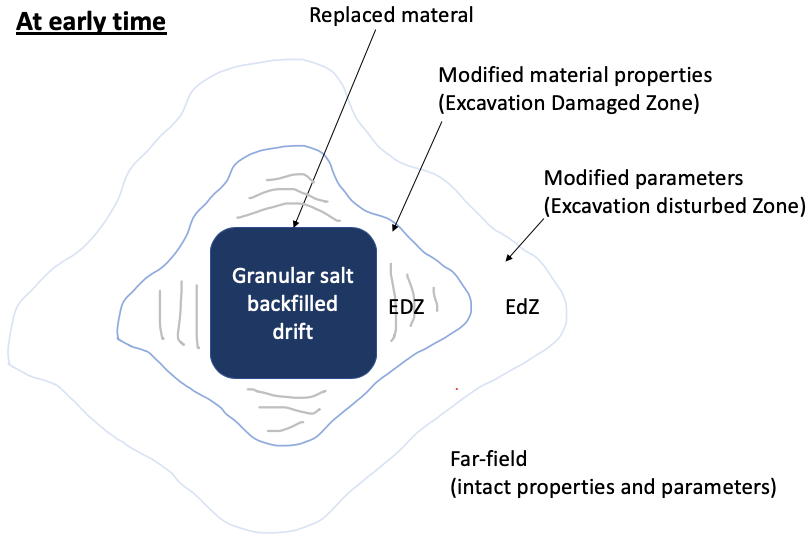
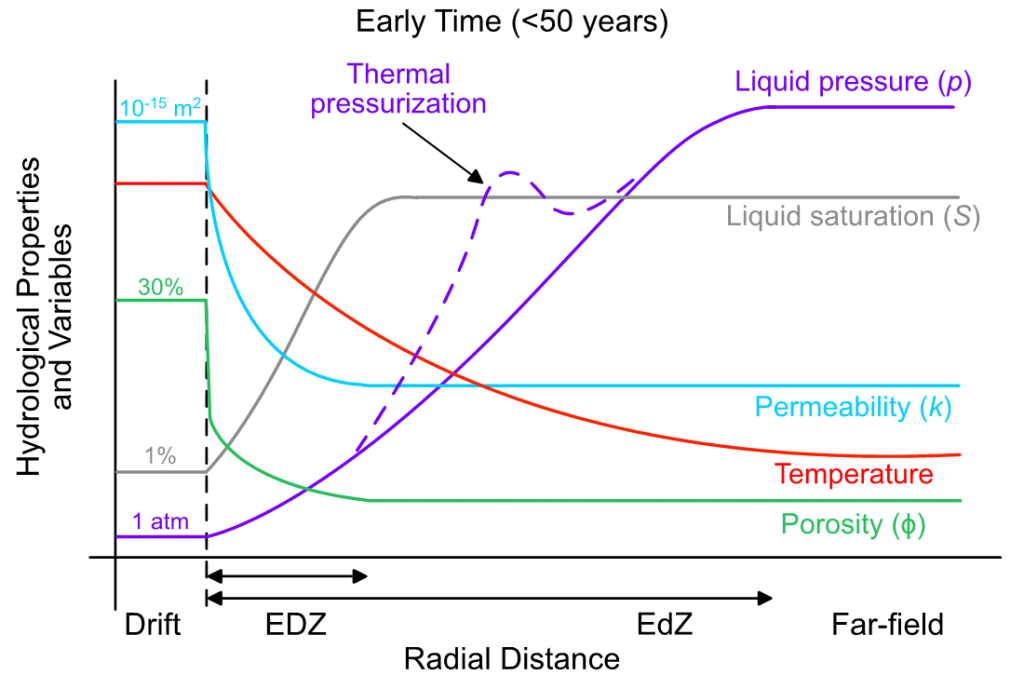
Data Collection
The data collected during BATS will be used to infer different mechanical, transport, and thermal properties of the salt. We will observe brine and gas migration during multiple phases of the test. As a control, the same properties are being monitored in the unheated array, about 7 meters away.
In the BATS tests we are measuring:
- Temperature of the salt using thermocouples grouted into boreholes;
- Closure of open heated and unheated boreholes;
- Amount and isotopic makeup of water flowing into open boreholes (removed as water vapor);
- Composition of the gas stream coming off the heated and unheated boreholes;
- Acoustic emissions from cracking and thermal expansion;
- Electrical conductivity of the rock using electrical resistivity tomography;
- Strain along fiber optic cables grouted into boreholes;
- Conditions in the drift around the experiment (barometric pressure, air temperature, relative humidity, air velocity);
- Strain and temperature in laboratory-built cement seals.
Although since the 1960s several key tests have been conducted around the world in salt related to the disposal of radioactive waste (i.e., Project Salt Vault, Asse, Avery Island – see bibliography), BATS is unique. BATS is monitoring brine availability in horizontal boreholes in bedded salt, which minimizes the number of layers intersected by boreholes (i.e., avoiding horizontal clay or anhydrite layers near the WIPP disposal horizon).
BATS is employing modern measurement and geophysical investigation techniques to better understand what impacts brine migration in salt will have on any possible future repositories for heat generating waste in salt. The thermal-hydrological-mechanical-chemical behavior of salt is complex, and all the processes are inter-related.
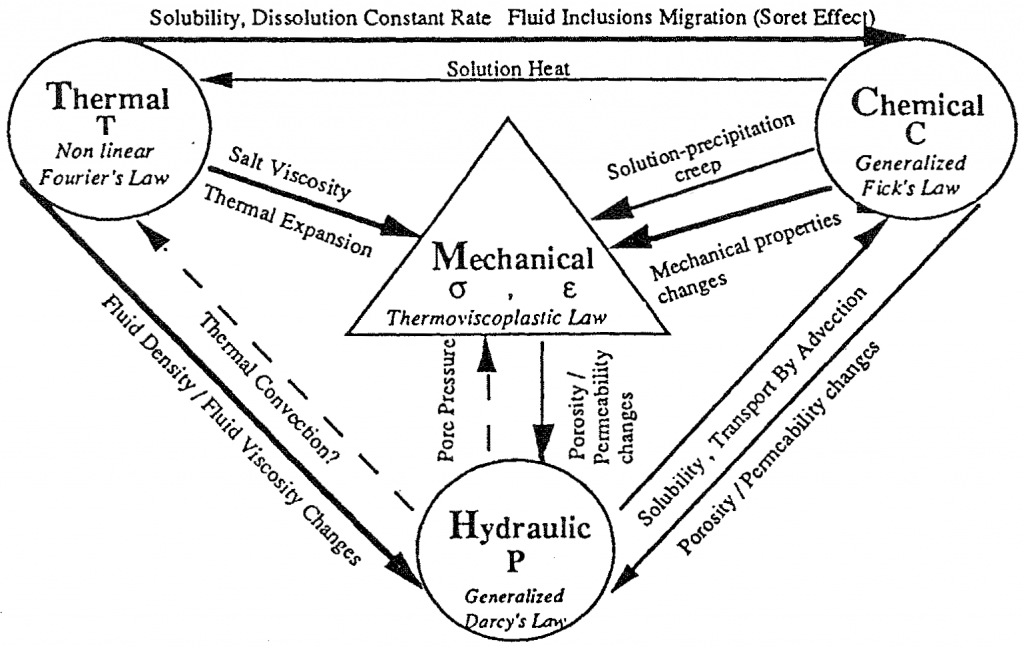
BATS is also giving experience and training to a new generating of US repository scientists at the participating national laboratories and is providing data for international collaboration and model benchmarking exercises (i.e., DECOVALEX).